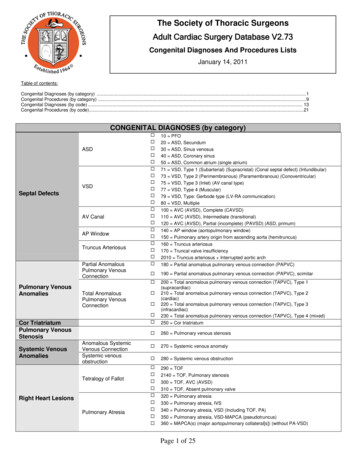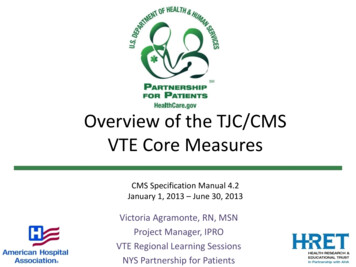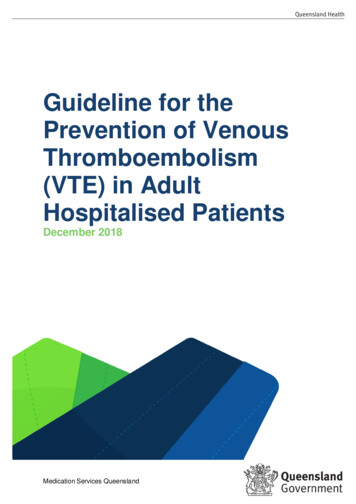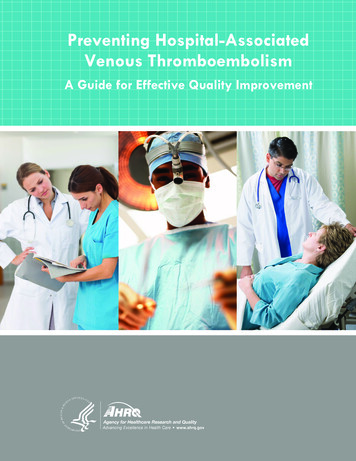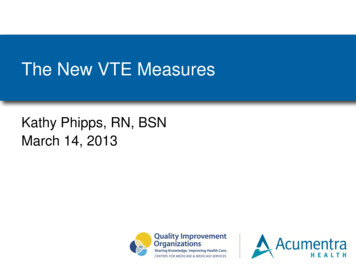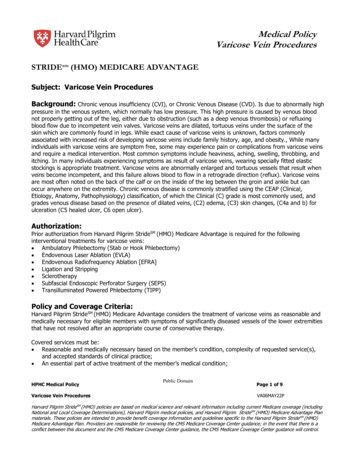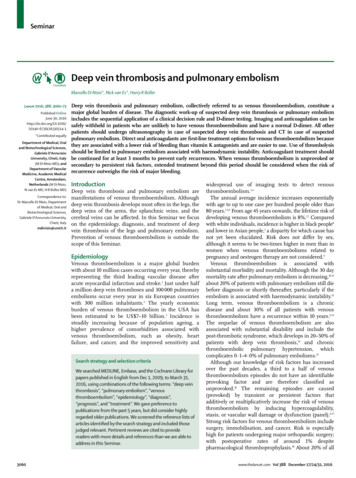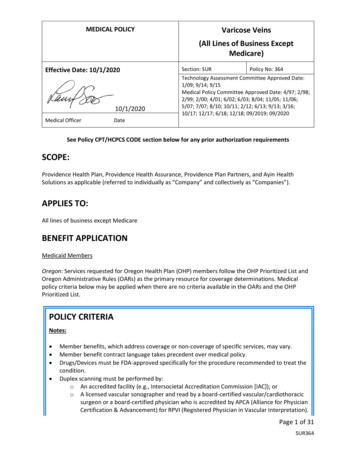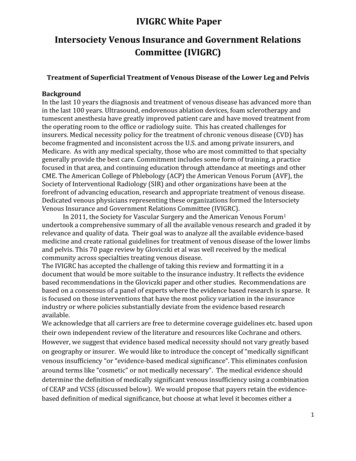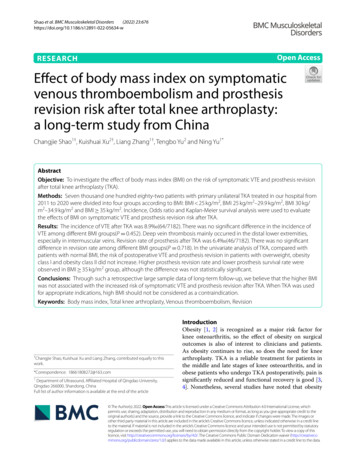
Transcription
Ahmad and Clayburgh Cancers of the Head & Neck (2016) 1:13DOI 10.1186/s41199-016-0014-9Cancers of theHead & NeckREVIEWOpen AccessVenous thromboembolism in head andneck cancer surgeryFaisal I. Ahmad and Daniel R. Clayburgh*AbstractBackground: Venous thromboembolism (VTE) is a major cause of perioperative morbidity and mortality. Historically,otolaryngology surgery has been seen as very low risk of VTE, given the relatively short procedures and healthypatient population. However, head and neck surgery patients have multiple additional risk factors for VTE comparedto general otolaryngology patients, and only recently has research been directed at examining this population ofpatients regarding VTE risk.Review: VTE has long been recognized as a major issue in other surgical specialties, with VTE rates of 15–60 % insome specialties in the absence of prophylaxis with either mechanical compression or anticoagulation. Multiplelarge-scale retrospective studies have shown that the incidence of VTE in otolaryngology patients is quite low,ranging between 0.1 and 1.6 %. However, these studies indicated that head and neck cancer patients may havean increased risk of VTE. Further retrospective studies focusing on head and neck cancer patients found a VTErate of approximately 2 %, but one study also found a suspected VTE rate of 5.6 % based on clinical symptoms,indicating that retrospective studies may underreport the true incidence. A single prospective study found a 13 %risk of VTE after major head and neck surgery. Furthermore, risk stratification using the Caprini risk assessmentmodel demonstrates that the highest risk patients may have a VTE risk of 18.3 %, although this may be lowered(but not eliminated) through the use of appropriate prophylactic anticoagulation.Conclusion: VTE is likely a more significant concern in head and neck surgery patients than previously realized.Appropriate prophylaxis with mechanical compression and anticoagulation is essential; risk stratification may serveas a useful tool to identify head and neck cancer patients at highest risk for VTE.BackgroundVenous thromboembolism (VTE), which includesdeep vein thrombosis (DVT) and pulmonary embolism (PE), is a common problem in hospitalized patients and can cause significant morbidity andmortality. This condition is responsible for 5 to 10 %of all hospital deaths, and is estimated to affect asmany as 600,000 patients a year in the United States[1]. Surgery increases the risk of VTE nearly 20-fold[2]. In the absence of prophylaxis, the estimated incidence of VTE among general surgery patients is 15to 40 % and is notably higher at 40 to 60 % in orthopedic surgery patients [3]. In the setting of cancer,surgery further doubles this risk compared to patients* Correspondence: clayburg@ohsu.eduDepartment of Otolaryngology- Head & Neck Surgery, Oregon Health andScience University, 3181 SW Sam Jackson Park Road, PV01, Portland, OR97239, USAwithout cancer [4]. The incidence of VTE also variesdepending on the type of cancer, with malignancies ofthe bone, ovary, brain and liver/pancreas associatedwith the highest incidences [5, 6].In a 2003 study including over 7 million patients in944 hospitals in the United States [7], VTE was the second most common serious post-operative complication.On average, a post-operative episode of VTE increasesthe patient length of stay by over 5 days, resulting inexcess charges of 21,000, and has a 6.56 % excessmortality rate. Furthermore, outpatient anticoagulationafter VTE is expensive, with 1 year of therapeutic anticoagulation and monitoring costing approximately 33,000 [8]. Nevertheless, post-operative VTEs arehighly preventable and represent the most commoncause of preventable 30-day surgical mortality in patientsundergoing cancer resection [6, 9]. Consequently,chemoprophylaxis with anticoagulants such as low- 2016 The Author(s). Open Access This article is distributed under the terms of the Creative Commons Attribution 4.0International License (http://creativecommons.org/licenses/by/4.0/), which permits unrestricted use, distribution, andreproduction in any medium, provided you give appropriate credit to the original author(s) and the source, provide a link tothe Creative Commons license, and indicate if changes were made. The Creative Commons Public Domain Dedication o/1.0/) applies to the data made available in this article, unless otherwise stated.
Ahmad and Clayburgh Cancers of the Head & Neck (2016) 1:13molecular-weight heparin or fondaparinux is frequentlyrecommended in post-operative patients [3].The risk of VTE in general otolaryngology has beenconsidered to be very low, as procedures are often doneon an outpatient basis and there is no associatedimmobilization or impairment of ambulation. Priorretrospective studies of general otolaryngology patientshave demonstrated a low risk of VTE, between 0.1 and2.4 % [10–13]. The bleeding risk associated with VTEchemoprophylaxis also presents a unique set of complications in head and neck surgery, including airwaycompromise, wound complications, and failure of microvascular reconstruction. As such, compliance with VTEchemoprophylaxis guidelines has been low among headand neck surgeons [14]. However, patients with headand neck cancer are intrinsically different than otherwisehealthy general otolaryngology patients, and often havemultiple risk factors for VTE development, includingmalignancy, pulmonary comorbidity, large, complex surgeries, and other medical problems. More recent studieshave indicated that head and neck surgery patients demonstrate substantially higher rates of VTE, reachingnearly 20 % in the highest-risk subgroups [12]. Thepurpose of this review is to examine the literature onincidence and prophylaxis of VTE in head and necksurgery patients.Venous thromboembolism pathophysiology andprophylaxisIn the 1800s, multiple pathologic factors—abnormalblood flow or stasis, endothelial injury, and hypercoagulability—were described as the etiologic agents for venous thrombosis. Dubbed Virchow’s triad, this provides aframework for understanding thrombus formation.Although an extensive list of risk factors are known forVTE (Table 1), all these risk factors can be distilleddown to affecting one or more of these central principlesof Virchow’s Triad. A review of the molecule underpinnings of coagulation are outside the scope of this paper,but have been reviewed extensively in other publications[15–19].Nevertheless, while the inciting mechanisms in situations of vascular injury are relatively well known, it issomewhat less clear how thrombus formation may occurin the setting of an intact endothelium, as occurs withvenous thromboembolism. In this setting, thrombus formation is likely much more dependent upon inflammation, stasis, and/or hypercoagulability. Both cancer andsurgery are well-known to induce pro-inflammatorystates and thus induce hypercoagulability, putting postsurgical patients, and oncologic surgical patients inparticular, at much higher risk for VTE development.Given the significant morbidity and mortality that maybe caused by VTE, prophylaxis against VTE has beenPage 2 of 8Table 1 Risk factors for venous erCancer therapyVenous compressionPrevious VTEIncreasing agePregnancy/postpartumOral contraceptive/HRTEstrogen receptor modulatorsErythropoiesis-stimulating agentsAcute medical illnessInflammatory bowel diseaseNephrotic syndromeMyeloproliferative disordersParoxysmal nocturnal hemoglobinuriaObesityCentral venous catheterizationInherited/acquired thrombophiliawidely studied. Methods of VTE prophylaxis can generally be divided into two broad categories: mechanicaland pharmacologic. Pharmacologic prophylaxis includesanticoagulants such as unfractionated heparin, lowmolecular weight heparin, fondaparinux, and warfarin.While these drugs increase bleeding risk after surgery,they to do provide significant protection from the development of VTE
[1]. Surgery increases the risk of VTE nearly 20-fold [2]. In the absence of prophylaxis, the estimated inci-dence of VTE among general surgery patients is 15 to 40 % and is notably higher at 40 to 60 % in ortho-pedic surgery patients [3]. In the setting of cancer, surgery further doubles this risk compared to patients without cancer [4].
